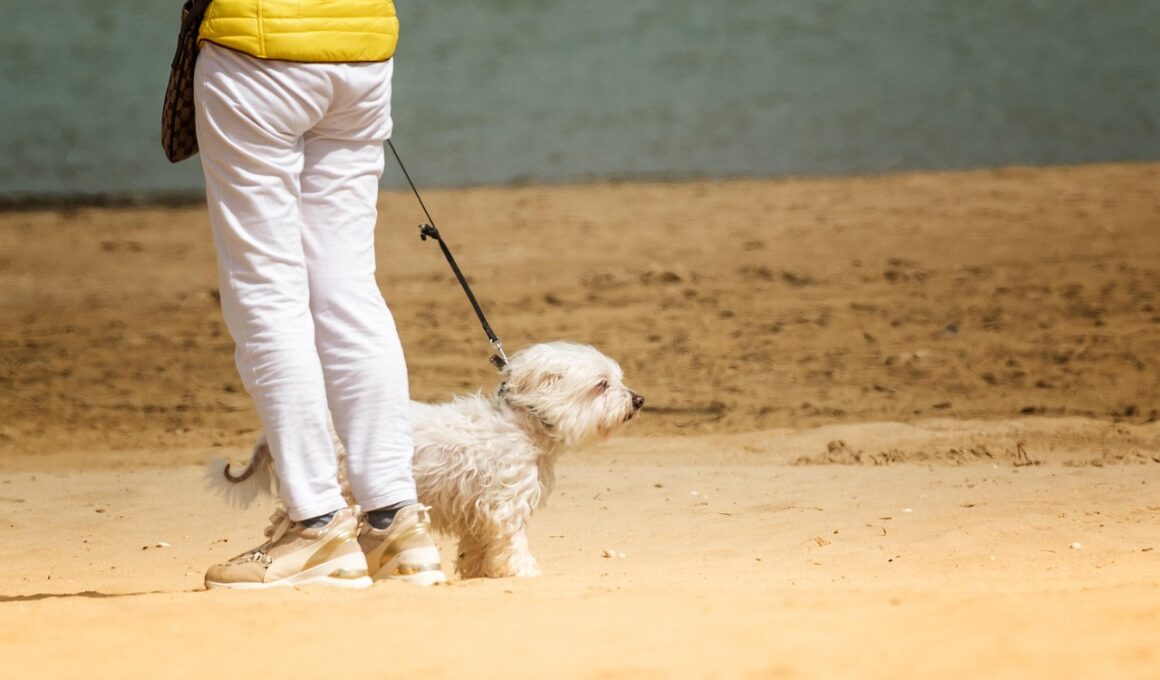Impact of Exercise on Cognitive Function in Senior Dogs
As our beloved dogs age, they may experience a decline in cognitive function. This condition, commonly referred to as Canine Cognitive Dysfunction (CCD), mirrors similar cognitive impairments in humans. Just like elderly people, senior dogs can face forgetfulness, confusion, and difficulty performing familiar tasks. Regular exercise has emerged as an essential tool in maintaining cognitive function for our older canine companions. In particular, physical activity promotes blood circulation, supports neurogenesis, and increases mental stimulation, which are vital to preserving and enhancing brain health in dogs. Engaging senior dogs in daily walks, playful activities, and social interactions not only aids their physical fitness but significantly impacts their cognitive well-being. Exercising through various activities, such as fetch or gentle tug-of-war, can keep their minds sharp and responsive. Consequently, incorporating a routine of exercise tailored specifically for senior dogs is not merely beneficial; it’s imperative for their overall health. Therefore, understanding how to effectively implement exercise regimens becomes crucial to enriching the lives of our furry friends, ensuring they enjoy their golden years with vigor and vitality.
The Connection Between Physical Activity and Brain Health
The link between physical activity and brain health in senior dogs can hardly be overstated. Exercise not only benefits the body but also has profound effects on mental clarity and emotional resilience. Engaging our senior dogs in regular walks or playtime promotes the release of endorphins, neurotransmitters that foster a sense of happiness and contentment. When dogs persist in physical activities, they develop healthier brain structures and better-functioning neural networks. Moreover, routines infused with playful experiences create positive associations and stimulate brain activity, combatting the effects of cognitive decline. Cognitive exercises, combined with physical activity, can enhance problem-solving skills and overall mental agility. Regular tasks such as learning new tricks or participating in scent work may provide additional mental stimulation, thus improving memory and recall. Therefore, a combination of physical and mental exercises helps develop a well-rounded approach to canine cognitive health. As we implement these practices, we can observe the improvement in our beloved canines’ mood and cognitive retention over time, leading to a happier, healthier life.
Choosing the Right Types of Exercise
When considering the exercise options available for senior dogs, it’s essential to select activities that are both enjoyable and safe. Not all exercises are suitable for every dog, especially those recovering from injuries or suffering from age-related conditions. Low-impact activities such as swimming, walking, or gentle hiking can be highly beneficial and easier on their joints. Additionally, incorporating mental stimulation through interactive games is a fantastic way to engage their minds while keeping them physically active. Simple tasks like retrieving an item, navigating a maze, or solving puzzle toys can be both fun and challenging for dogs. Offering a mix of both physical and mental challenges can ensure a greater balance in their exercise routine. Furthermore, considering your dog’s age, breed, and overall health will help determine the appropriate intensity and duration of these activities. Since senior dogs may tire more quickly, it is crucial to monitor for signs of fatigue or discomfort. Adjustments should be made to their exercise routines in order to keep them healthy and happy throughout their senior years.
The Role of Social Interaction in Exercise
Social interactions play a vital role in enhancing exercise programs for senior dogs. Whether it’s joining a dog walking group or simply playing with other dogs, the social aspect of exercise can greatly increase a dog’s motivation to stay active. Engaging with fellow canine companions not only promotes physical activity but also impacts mental health positively. Dogs are social animals, and they thrive in environments where they can interact with others. Buddy games or playdates can offer valuable experiences and engaging interactions that stimulate both body and mind. Mental engagement during these social activities helps reduce feelings of loneliness and isolation, which often accompany cognitive decline. The emotional bond that strengthens through social exercises can additionally uplift their spirits and overall mood. Therefore, facilitating social interactions, whether with other dogs or humans during exercise sessions, can enhance the effectiveness of a senior dog’s workout routine. It fosters positive experiences and socialization, aiding in the prevention of behavioral issues that may arise from feelings of boredom or anxiety.
Tracking Progress and Celebrating Achievements
Keeping track of exercise routines and celebrating progress can motivate both the owner and the senior dog. Monitoring improvements in a dog’s physical capability and cognitive function becomes especially important. This tracking may involve simple journaling, app usage, or joining pet-focused communities that encourage sharing experiences. By consistently logging exercises, owners can assess which activities benefit their dog the most, adjusting them accordingly to maximize effectiveness. Small milestones, like increasing walking distances or mastering a new trick, should be celebrated enthusiastically. Rewards such as treats, pats, or praises can reinforce positive behavior and strengthen the bond between the dog and owner. This practice not only fosters a sense of accomplishment for the owner but also boosts the dog’s confidence. Setting achievable goals enables senior dogs to experience a rewarding path, leading to a more enjoyable exercise regimen. A gradually increasing challenge also keeps their routines interesting and engaging, preventing monotony. Through this approach of tracking and celebrations, we can ensure lasting benefits, creating a meaningful bond throughout their senior years.
Consistency in Exercise Regimens
Consistency in exercise regimens is crucial for maintaining cognitive health in senior dogs. Establishing a routine promotes a sense of security in our furry friends while fostering better engagement in physical activities. By scheduling regular outings for walks, playtime, or mental exercises, dogs become accustomed to their new lifestyle. This predictability encourages routine participation, ultimately leading to enriched cognitive function. However, balance is important to consider. While routines are beneficial, varying the types of exercises can prevent boredom. Mixing up activities such as agility training, swimming, and simple games introduces excitement, ensuring that every session feels unique. Regular engagement through various activities combined with consistency can stimulate different areas of the brain, maximizing cognitive and physical benefits. Moreover, monitoring the dog’s responses to different exercises helps fine-tune routines tailored to their specific needs. As their owner, being diligent about maintaining exercise consistency demonstrates commitment to their well-being. In turn, your senior dog’s enthusiasm for physical activities becomes evident, improving their quality of life as they age and thrive.
Potential Challenges and Solutions
Common Hurdles in Maintaining an Exercise Routine
While implementing a consistent exercise routine for senior dogs is essential, several potential challenges may arise. Health issues, such as arthritis, mobility limitations, or fatigue, often hinder regular physical activity. Identifying these hurdles early allows for necessary adaptations to ensure safety while still creating opportunities for exercise. Alternatives such as shorter, more frequent walks or utilizing canine wheelchairs can address mobility concerns while maintaining activity levels. Additionally, environmental factors like weather extremes might deter outdoor exercises, necessitating indoor alternatives. Activities like indoor fetch or agility courses can help mitigate these problems, ensuring fitness continues in any setting. Finding the right balance between engaging the dog’s interests while considering their physical limitations can be tricky but essential. Social support from fellow dog owners or pet trainers can provide motivation and new ideas for fun activities. Regular veterinary check-ups can also offer guidance tailored to each dog’s health needs, discussing suitable exercise options to ensure a fulfilling routine. Addressing these challenges can create a sustainable exercise plan that benefits the dog’s cognitive and physical health.
Conclusion: Prioritizing Senior Dog Health
In conclusion, prioritizing exercise for senior dogs is vital for maintaining cognitive function and improving overall well-being. Through a structured, consistent approach combining physical activity, mental stimulation, and social interaction, dogs can experience enhanced quality of life as they age. Understanding the significance of routines tailored to their individual needs empowers dog owners in promoting healthy aging. Exercise offers not only substantial mental health benefits but also strengthens the bond between owner and pet. These loyal companions bring immeasurable joy into our lives, and in return, we must advocate for their health and happiness. It is our responsibility to create engaging and supportive environments for them in their golden years. By continuing this important focus on exercise and cognitive care, we can help our beloved dogs enjoy their later years contently and vibrantly. Making movement a priority is an investment in their long-term health and happiness. Therefore, we should embrace the positive changes exercise can bring, ensuring our senior dogs thrive with vitality. As we celebrate their ongoing journey together, let us commit to using our knowledge and resources to empower their health and well-being.


